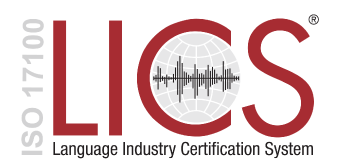Our perception is largely influenced by our culture and the language we speak. They are like glasses through which we see the world. They determine what meanings we associate with colors, symbols, gestures, pictures, words and much more.
Have you ever found yourself lost on a website with an utterly confusing user interface? A website where you couldn’t find the menu items you were looking for and the symbols just didn’t do what you had expected them to do? Then you probably visited a website where localisation went wrong.
Everybody seems to be talking about it, but what is localisation exactly? What does game localisation or website localisation actually mean? And why is it so essential for international success?
Here at EHLION language consultancy, localisation and translation are our daily business. This is why we have put together all you need to know about localisation, why it is different from translation and how it fits into the context of internationalization and globalization.
Localisation vs. translation
What does localisation mean? When it comes to transferring content into different languages the terms translation and localisation are often used synonymously, but it is important to know that they mean different things.
Translation definition:
Translation is the process of converting a written text from a source language into a target language, in a way that ensures that the message is received correctly by the target audience.
Localisation definition:
Localisation is the process of adapting content or a product to a target market. Therefore, translation is often a part of the localisation process, but it takes much more than just language localisation, for a successful content or product localisation.
In order for an audience to resonate with a message and to make sure the message is conveyed exactly in the way it was meant to, it is important to take the cultural background into account and modify the content accordingly.
Other aspects of the localisation process are:
- Chaining content, e.g. photos, to suit the preferences of the target market
- Modifying graphics, design and colors
- Pay attention to consumer habits
- Pay attention to religious traditions
- Check legal requirements of the local market
- Formatting dates (order of day, month, year), phone numbers and addresses
- Units of measurement (pounds, kilograms, inches, centimeters, etc.)
- Converting to local currencies
- At times product names need to be changed to fit the target market
In short: A successful localisation will make people feel as if the content was only created for them in the first place.
Localisation makes products and content appealing to the target audience, which likely results in an increased demand for the product or service offered. Because in order for people to engage they need something to identify with, something that has to do with them. If something feels too unfamiliar, they might engage in a different way or not engage at all.
Some areas in which localisation is needed:
- Website localisation
- App localisation
- Software localisation
- Game localisation
- Localisation of marketing materials
- User Interfaces
- Training materials
Why localisation is important?
Your website is like your business card. If your corporate website is available in different languages you want to make sure that it is perfectly tailored to the relevant target market.
Apart from translating the website, that can mean replacing photos that are a better fit for the target audience or changing the colors, because they have a different meaning in a different country.
For example, in Japan white is the color for death and not black. And while we use green fonts to indicate the ascending values of shares and red for the descending numbers on the stock market, in Taiwan it is the exact opposite. Because the color red, in Taiwan symbolizes happiness and good luck.
Sometimes the language itself requires a different user interface and a new design. For example, languages like Hebrew that are read from right to left and not from left to right, automatically require a different layout.
Examples of localisation
McDonalds
Take a look at the McDonalds website in English, Chinese and Hebrew. Pay attention to the different symbols, the photos, the design and the placement of the menu and it will be obvious, why localisation is way more than just translation.



As you will have noticed, even the website for the US and for the UK looks slightly different. Although they are both in English, they are still different, each individually tailored to their target market.
Those examples show that different professions are involved in a successful localisation project.
This is why EHLION works with a team of qualified translator, web developers and IT experts on your localisation project. And of course, we will also help you with the search engine optimization (SEO translations) of your content for a new target audience.
If you want to expand internationally and are looking for a partner to help you achieve that, contact us for a free initial consultation. We offer a wide range of localisation services, from website localisation over app localisation to software localisation.
Localisation gone wrong
Sometimes the best way to show why something is important is to take a look at what happens, when it was done wrong or simply not done at all. Here are some real-life examples for localisation gone wrong.
Let’s start with some examples of what can go wrong when you opt for translation, when in reality localisation was needed.
American Airlines used the slogan “Fly in Leather” to introduce their first-class leather seats. For the Mexican market they used the literal translation “Vuela en cuero” which can also be understood as “fly naked”.
When it comes to creating a slogan for different target markets a lot of creativity is required as word plays or idioms often don’t have the same effect when translated or they simply can’t be translated. In those cases, it makes sense to consider a transcreation. Read all about transcreation in our magazine article “What is transcreation?”.
At some point during localisation process, the company has to face the question: should we change the brand name or the product name or should we keep it? This is especially relevant, when the original name is hard to pronounce or associated with something that doesn’t support the brand identity.
Especially car companies didn’t do well in the past when it came to that. They didn’t change the name for their new car model. In retrospect they probably wish they had.
When Ford launched its Pinto in Brazil it was mocked, because in Brazilian Portuguese “pinto” is also a reference to small male genitalia.
The Chevrolet model “Nova” did do much better on the Latin American market, which isn’t really a surprise for Spanish speakers, because “no va” can be translated as “does not work” (literally: it’s not going).
Localisation vs. internationalization
Now that we have talked extensively about localisation, let’s differentiate internationalization and localisation.
The goal of internationalization is to design a product in such a way that it can be adapted to various national markets and languages. The product is often a software application that is designed in a way that can be easily adapted to different regions. You could say that localisation is the next step in which the product or the service is actually adapted to one of those target markets.
Globalization vs. localisation.
Our world is becoming more and more globalized. When the raw material for a product comes from Thailand, is made in China and sold in the US, there is no doubt that the company is operating on a global scale.
When businesses start operating on an international scale or when products, technology or investment spread across national borders, we talk about globalization.
But what is the relationship between globalization and localisation?
In short, without globalization there would be no need for localisation. The need for localisation arises as soon as a company wants to expand beyond national borders.
Internationalization vs. localisation vs. globalization
When it comes to your business and those three concepts, there are four words to keep in mind to be successful on an international level.
THINK GLOBAL, ACT LOCAL
Conclusion – localisation is a key to international success
If you want to be successful when going global, there is no way around localisation. It helps you to unlock new markets and revenue streams for your business.
When products, services or your content is localised and tailored to the target market, customers will be more likely to engage with it and make a purchase.
Our examples have shown what can happen, when you saved at the wrong end, while it is entertaining to read, it was a disaster for the company.
So, when you think global, act local.
EHLION is your partner for your localisation project, we work with highly skilled professionals around the globe and offer our language services in more than 100 languages and over 800 language combinations.
You are in need of a professional translation or localisation services, but you don’t know how the next steps looks like? Contact EHLION for a free consultation today. Our project managers are happy to help you.













